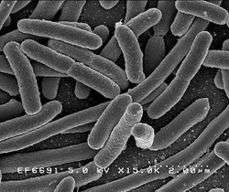Neutrophile

A neutrophile is a neutrophilic organism[2] that thrives in a neutral pH environment between 6.5 and 7.5.[3]
Environment
The pH of the environment can support growth or hinder neutrophilic organisms. When the pH is within the microbe's range, they grow and within that range there is an optimal growth pH.[4] Neutrophiles are adapted to live in an environment where the hydrogen ion concentration is at equilibrium.[2] They are sensitive to the concentration, and when the pH become too basic or acidic, the cell's proteins can denature.[4] In acidic conditions, neutrophiles have a few defenses including decreasing membrane fluidity, repairing DNA that has been damaged, and increasing the pH of the environment surrounding it.[5] Depending on the microbe and the pH, the microbe's growth can be slowed or stopped altogether.[6] Manipulation of the pH of the environment that the microbe is in is used by the food industry to control its growth in order to increase the shelf life of food.[6]
References
- ↑ Nutrition, Center for Food Safety and Applied. "Safe Practices for Food Processes - Evaluation and Definition of Potentially Hazardous Foods - Chapter 3. Factors that Influence Microbial Growth". www.fda.gov. Retrieved 2016-11-03.
- 1 2 Parvathi, V. Deepa. Microbiology for Nurses. Pearson Education India. ISBN 9789332540668.
- ↑ Tortora, Funke, Case (2015). Microbiology: An introduction. Benjamin-Cummings Publishing Company, Subs of Addison Wesley Longman, Inc. p. 152. ISBN 0321929152.
- 1 2 "Properties of Microbes". www.brooklyn.cuny.edu. Retrieved 2016-11-01.
- ↑ Jain, Pradeep; Sinha, Sarika (2008-12-31). "Neutrophiles: Acid Challenge and Comparison with Acidophiles". The Internet Journal of Microbiology. 7 (1).
- 1 2 Nutrition, Center for Food Safety and Applied. "Safe Practices for Food Processes - Evaluation and Definition of Potentially Hazardous Foods - Chapter 3. Factors that Influence Microbial Growth". www.fda.gov. Retrieved 2016-11-01.